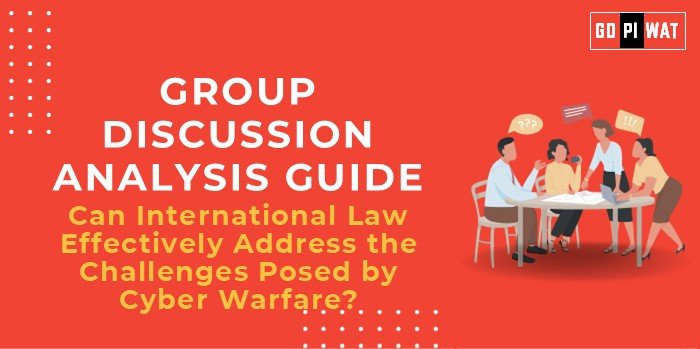📋 Group Discussion (GD) Analysis Guide: Can International Law Effectively Address the Challenges Posed by Cyber Warfare?
🌐 Introduction to the Topic
- 📌 Opening Context: Cyber warfare, involving state and non-state actors, is a growing threat to global security. Its covert nature and rapid evolution challenge traditional international law.
- 📖 Topic Background: The Tallinn Manual (2013) offers guidelines on cyber warfare, but international law lacks comprehensive enforceability in this domain. Incidents like the SolarWinds attack (2020) and disruptions during the Ukraine conflict spotlight the need for robust legal frameworks.
📊 Quick Facts and Key Statistics
🌍 Global Cyberattack Costs: $8 trillion in 2023, projected to rise to $10.5 trillion by 2025 (Cybersecurity Ventures).
🛡️ State-Sponsored Cyber Operations: Over 40% of cyberattacks in 2023 involved state actors (Microsoft Digital Defense Report).
🌐 Countries Affected: 140+ nations targeted by cyberattacks in 2022 (UN ICT report).
💰 Budgets for Cybersecurity: US allocated $10.9 billion in 2023, reflecting rising prioritization.
🛡️ State-Sponsored Cyber Operations: Over 40% of cyberattacks in 2023 involved state actors (Microsoft Digital Defense Report).
🌐 Countries Affected: 140+ nations targeted by cyberattacks in 2022 (UN ICT report).
💰 Budgets for Cybersecurity: US allocated $10.9 billion in 2023, reflecting rising prioritization.
👥 Stakeholders and Their Roles
- 🏛️ United Nations: Works through forums like the UN Group of Governmental Experts (GGE) on advancing international cybersecurity norms.
- 🌍 Nations: Develop cybersecurity frameworks, such as the US Cyber Command and China’s Great Firewall strategies.
- 📈 Private Sector: Tech companies like Microsoft and Google offer critical cyber threat intelligence and incident response.
- 🌱 International Organizations: The NATO Cooperative Cyber Defence Centre of Excellence (CCDCOE) shapes regional strategies.
🏆 Achievements and Challenges
✨ Achievements:
- 📜 Tallinn Manual Development: Establishes legal principles for cyber conflicts.
- 🤝 Regional Cooperation: NATO Cyber Defense initiatives enhance collaboration.
- 🌏 Cybersecurity Frameworks: Nations like Estonia lead globally in cyber resilience.
⚠️ Challenges:
- 🔍 Attribution Difficulties: Identifying attackers is complex, enabling impunity.
- ⚖️ Lack of Consensus: Disagreements between major powers (e.g., US vs. China) hinder progress.
- ⚡ Rapid Evolution: Cyber tactics outpace legal developments.
🌍 Global Comparisons:
- ✔️ Estonia (2007): Cyberattack response spurred international cooperation and Tallinn Manual drafting.
- ❌ China: Strong domestic control but reluctance in global law participation.
Case Studies:
- 💻 SolarWinds Hack (2020): Highlighted gaps in global attribution and response mechanisms.
- 📉 NotPetya Attack (2017): An example of economic warfare via cyber means, costing $10 billion globally.
📢 Structured Arguments for Discussion
- ✅ Supporting Stance: “International law can curb cyber warfare by setting binding norms, as seen with limited progress under the Tallinn Manual.”
- ❌ Opposing Stance: “Cyber warfare’s anonymity and rapid pace render international law ineffective without robust enforcement mechanisms.”
- ⚖️ Balanced Perspective: “While international law faces significant limitations, multilateral efforts and public-private partnerships offer pathways to address challenges.”
🧠 Effective Discussion Approaches
- 🎯 Opening Approaches:
- Use a striking fact: “Cybercrime costs are set to hit $10.5 trillion by 2025, demanding urgent legal reforms.”
- Highlight a case study: “The SolarWinds hack exposed international law’s incapacity to manage cyber threats.”
- 🤝 Counter-Argument Handling:
- Emphasize existing efforts like UN GGE, propose technical collaborations for enforcement, and highlight successes like NATO’s Cyber Defence Centre.
📊 Strategic Analysis of Strengths and Weaknesses
- 🌟 Strengths: Facilitates multilateral discussions, creates a foundation for cyber norms.
- ⚠️ Weaknesses: Enforcement gaps, jurisdictional limitations.
- 📈 Opportunities: Aligning nations on cyber treaties, engaging private sector expertise.
- ⚡ Threats: Escalating geopolitical tensions, cyber arms race.
🎓 Connecting with B-School Applications
- 💼 Real-World Applications: Explore themes like risk management in cyber resilience and regulatory frameworks for tech industries.
- 📚 Sample Questions:
- “How can businesses collaborate with governments to address cyber warfare?”
- “What role can international law play in shaping cybersecurity policies?”
- 💡 Insights:
- Learn about cross-border legal challenges and their impact on corporate governance in the digital era.


